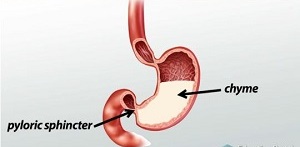
After hours of mechanical and chemical digestion, food has been reduced into chyme. As particles of food become small enough, they are passed out of the stomach at regular intervals into the small intestine, which stimulates the pancreas to release fluid containing a high concentration of bicarbonate. This fluid neutralizes the gastric juices, which can damage the lining of the intestine and result in duodenal ulcer. Other secretions from the pancreas, gallbladder, liver, and glands in the intestinal wall help in digestion.
When food particles are sufficiently reduced in size and composition, they are absorbed by the intestinal wall and transported to the bloodstream. Some food material is passed from the small intestine to the large intestine. In the large intestine, bacteria break down any proteins and starches in chyme that were not digested fully in the small intestine.
When all of the nutrients have been absorbed from chyme, the remaining waste material changes into semisolids that are called feces. The feces pass to the rectum, to be stored until ready to be discharged from the body during defecation.
Picture Credit : Google

